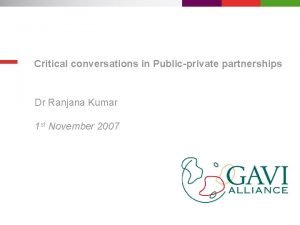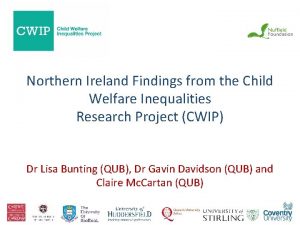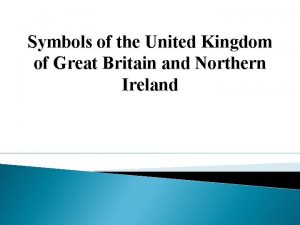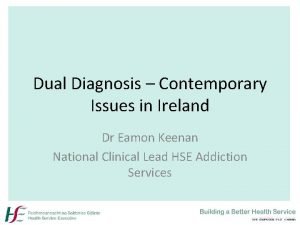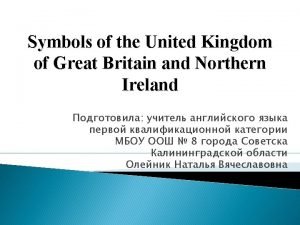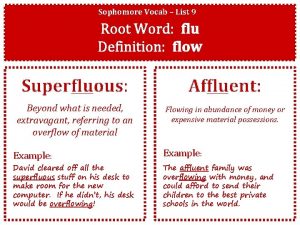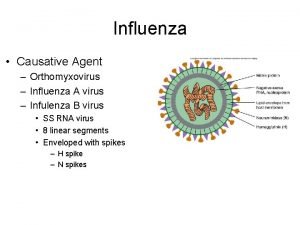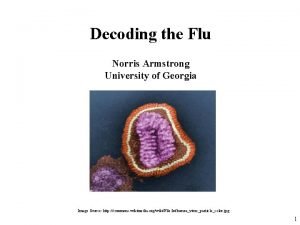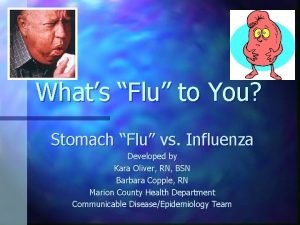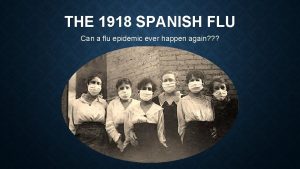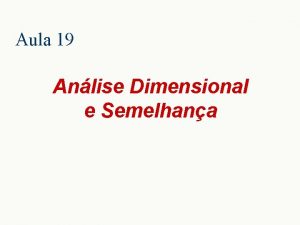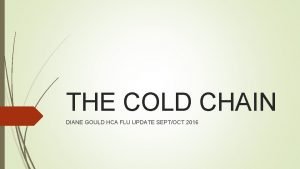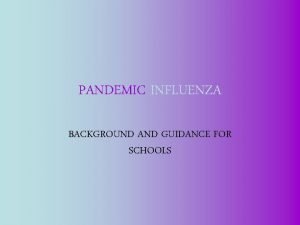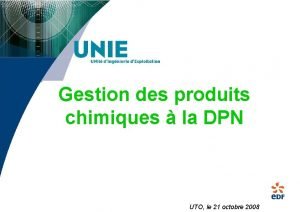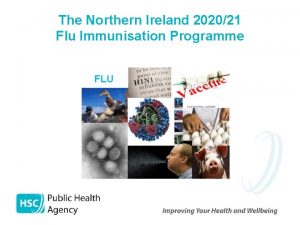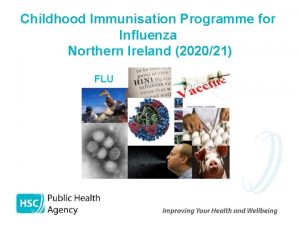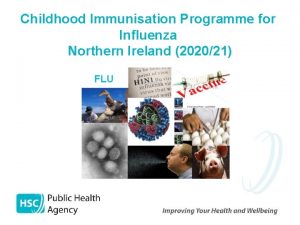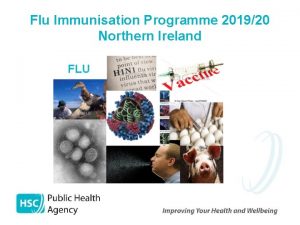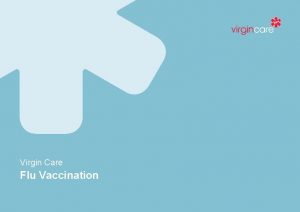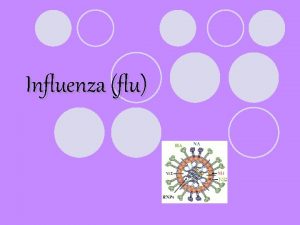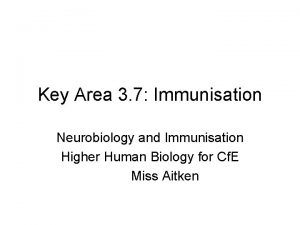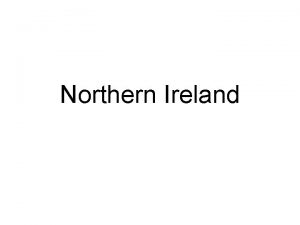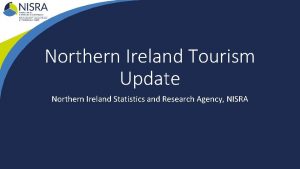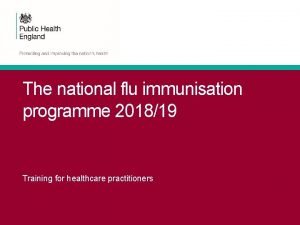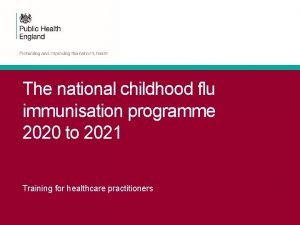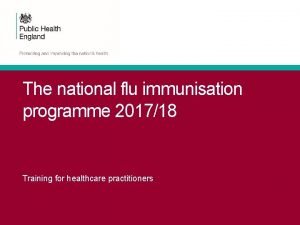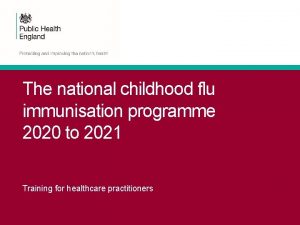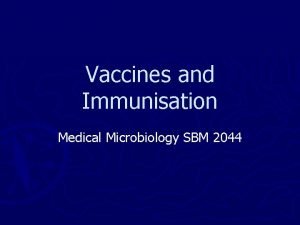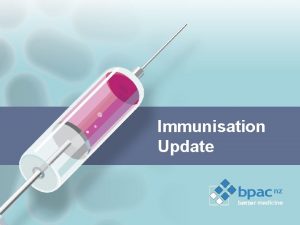The Northern Ireland 202021 Flu Immunisation Programme Key








































































- Slides: 72

The Northern Ireland 2020/21 Flu Immunisation Programme

Key Messages • flu immunisation is one of the most effective interventions we can provide to reduce harm from flu and pressures on health and social care services during the winter • it is important to increase flu vaccine uptake in clinical risk groups because of increased risk of death and serious illness if people in these groups catch flu • In previous year only around half of patients under 65 years in clinical risk groups have been vaccinated. • Influenza during pregnancy may be associated with perinatal mortality, prematurity, smaller neonatal size, lower birth weight and increased risk of complications for mother • vaccination of health and social care workers protects them and reduces risk of spreading flu to their patients, service users, colleagues and family members • by preventing flu infection through vaccination, secondary bacterial infections such as pneumonia are prevented. This reduces the need for antibiotics and helps prevent antibiotic resistance

Impact of COVID pandemic on 2020 -21 flu vaccine programme • This year high uptake of flu vaccine is even more crucial this ever • Those most at risk from flu are also the most vulnerable to COVID-19 related morbidity and mortality. There is evidence that co-infection of COVID and flu can increase mortality. • This year, the Department of Health has obtained extra flu vaccine to significantly increase uptake targets for all groups and to expand eligibility to new groups • New eligible groups include: all School Year 8 children and household contacts of individuals that received a shielding letter during COVID • From December flu vaccine may be extended to all 50 to 64 year olds depending on uptake and vaccine availability but are NOT eligible prior to policy announcement • Delivery of the programme will be more challenging because of the likelihood of increased demand from the public and the need to achieve higher uptake whilst adhering to social distancing and Infection Control Guidance

Aims of this resource The purpose of this training resource is to: • develop the knowledge base of healthcare practitioners regarding the 2020/21 seasonal flu vaccination programme • support healthcare practitioners involved in discussing flu vaccination with those eligible by providing evidence based information • promote high uptake of flu vaccination in those eligible by increasing the knowledge of those involved in delivering the vaccination programme • provide information on the administration of flu vaccines

What is Flu? v Influenza (or flu) is a viral infection affecting the respiratory tract v Is highly infectious and spreads rapidly in closed communities v Can be spread by people with mild / no symptoms v Usually occurs most often in an 8 -10 week period during the winter

Type of Influenza viruses There are three types of flu vaccines: Type A viruses • Causes the majority of seasonal flu cases • Always the cause of pandemics • Animal reservoir – birds, wildfowl, also carried by other mammals B viruses • Associated with low-level sporadic disease • Burden of disease mostly in children • Predominantly found in humans C viruses • Minor respiratory illness only

Flu A virus Genetic material (RNA) in the centre Two Surface Antigens Two surface antigens: • Haemagglutinin (H) • Neuraminidase (N) There are 18 different types of H and 11 different types of N e. g. H 3 N 2 or H 1 N 1

Genetic changes in the flu virus – what this means • Changes in surface antigens result in the virus constantly changing • Antigenic Drift: Minor changes (natural mutations) in the genes of flu A viruses occur gradually over time from season to season • Antigenic Shift: When two or more different strains combine. This abrupt change may result in a new Flu A subtype Immunity from previous flu infections/vaccinations may not protect against the new subtype potentially lead to widespread epidemic or pandemic • WHO monitors epidemiology throughout the world and the recommends the strains of influenza A and B predicted to be circulating in the forthcoming winter. These strains are included in the flu vaccine developed each year

Flu vaccine effectiveness (VE) • • • The UK has a well-established system to monitor influenza VE each season using data from primary care schemes in England, Scotland, Wales and Northern Ireland VE varies from one season to the next Over the years, efficacy of the standard egg grown flu vaccines has been calculated around 50 -60% for adults aged 18 to 65 years Efficacy in elderly has always been lower for the non-adjuvanted egg grown inactivated vaccines although the immunisation has still been shown to reduce incidence of severe disease including bronchopneumonia, hospital admissions and mortality Growing flu viruses in eggs results in egg-adapted changes that cause differences between the viruses in the vaccine and the ones that circulate and thus reduce their effectiveness

Flu vaccine effectiveness for last year - 2019/20 • Provisional overall adjusted end-of-season VE for 2019/20 was significant at 43% against laboratory-confirmed flu • Highest against influenza A(H 1 N 1)pdm 09 (54%) and lower against influenza AH 3 N 2 (31%) (similar to previous two seasons) • Surveillance Influenza and other respiratory viruses in the UK 2019 to 2020 • Adjuvanted vaccines (a. TIV) and egg free cell manufactured vaccines have been developed in recent years to improve efficacy in the elderly and avoid egg adaption VE studies still limited but early evidence shows higher efficacy in the elderly with Adjuvanted Inactivated Vaccines •

Features of flu Easily transmitted by droplets, small-particle aerosols and by hand to mouth/eye contamination from a contaminated surface or respiratory secretions of infected person People with mild or no symptoms can still infect others Incubation period 1 -5 days (average 2 -3 days) though may be longer especially in people with immune deficiency Common symptoms include: l l l Sudden onset of fever, chills, headache, muscle and joint pain and extreme fatigue Dry cough, sore throat and stuffy nose In young children, gastrointestinal symptoms such as vomiting and diarrhoea, may be seen

Possible complications of flu Common: Bronchitis • otitis media (children), sinusitis • secondary bacterial pneumonia • Less common: meningitis, encephalitis, meningoencephalitis • primary influenza pneumonia • Risk of most serious illness is higher in – children under six months – older people – those with underlying health conditions such as respiratory disease, cardiac disease, long-term neurological conditions or immunosuppression – pregnant women (flu during pregnancy may be associated with perinatal mortality, prematurity, smaller neonatal size and lower birth weight) 12

FLU EPIDEMIOLOGY

GP flu/FLI consultation rates and weekly flu outbreaks 25 Very High 120 High 100 80 Moderate 60 40 Number of laboratory confirmed outbreaks Flu/FLI consultation rate per 100, 000 population 140 20 15 confirmed/suspected respiratory-related outbreaks § 9 confirmed flu – 8 flu A, 1 flu B § 6 suspected FLI 178 confirmed/suspected COVID-19 outbreaks § 111 confirmed § 67 suspected 15 10 5 Low 20 Baseline 0 40424446485052 2 4 6 8 101214161820222426283032343638 Year/Week 2010 -11 2018 -19 2019 -20 0 444546474849505152 1 2 3 4 5 6 7 8 9 10111213141516171819202122 Week Covid-19 nursing/residential setting Flu nursing/residential setting Covid-19 hospital setting Flu hospital setting Covid-19 other setting Flu other setting The baseline MEM threshold for Northern Ireland is 14. 7 per 100, 000 population for 2019 -20. Low activity is 14. 7 to <23. 9, moderate activity 23. 9 to <73. 9, high activity 73. 9 to <121. 7 and very high activity is >121. 7

450 70 400 1200 50% 45% 60 300 50 250 40 200 30 150 20 100 Number of tests 1000 350 40% 35% 800 30% 600 25% 20% 400 15% 10% 200 10 50 404448524 812162024283236 2018 -19 Start of 2019 -20 season Flu A not subtyped Flu AH 3 Flu A(H 1 N 1) 2009 0 5% 0 0% 40 42 44 46 48 50 52 2 4 6 8 10 12 14 16 18 20 22 24 26 28 30 32 34 36 38 0 Proportion positive 80 Number of laboratory reports Flu/FLI consultation rate per 100, 000 population Weekly number of flu laboratory reports with weekly GP consultation rates for ‘flu/FLI’ and proportion positivity Week 2018 -19 No Tested 2018 -19 Proportion positive 2019 -20 No Tested 2019 -20 Proportion positive

Influenza Weekly Surveillance Bulletin, Northern Ireland, 2019/20 Public Health Agency weekly Flu Surveillance Bulletin

National Flu Vaccination Programme • Late 1960 s: recommended to directly protect those in clinical risk groups at higher risk of influenza associated morbidity and mortality • 2000: extended to include all people aged 65 years or over • 2010: pregnancy added as a clinical risk category for routine flu vaccine • 2013: All pre-school children from 2 years and primary school children • 2020: COVID Pandemic with increased flu vaccine investment to enable uptake of 85 -95% in existing groups AND to expand offer to Year 8 school children & household contacts of individuals that received a shielding letter

Northern Ireland Flu Vaccine Programme policy: outlined in annual CMO letter 2020/21 Published 18 th August 2020 § Department of Health (NI) CMO Letter

2020/21 increased Uptake Targets as outlined in the annual CMO letter

2020/21 increased Uptake Targets as outlined in the annual CMO letter Ø Vaccine uptake rates (as per previous years) only apply to Trust frontline health and social care workers

Eligibility for 2020/21 season § All individuals aged 65 years or over § Individuals aged 18 to 64 years in a clinical risk group § Children aged 6 m to 2 y and 12 to 17 years in a clinical risk group or who a household contacts of very severely immunocompromised § All children aged 2 – 12 years (pre-school, primary school & post –primary school Year 8) § Individuals living in long-stay residential care homes or facilities § Main carers of an elderly / disabled person § Household contacts of individuals that were shielding during COVID § Health & social care staff in direct contact with patients / clients

Clinical risk groups Clinical risk category Chronic respiratory disease Examples (this list is not exhaustive and decisions should be based on clinical judgement) Asthma that requires continuous or repeated use of inhaled or systemic steroids or with previous exacerbations requiring hospital admission. Chronic obstructive pulmonary disease (COPD) including chronic bronchitis and emphysema; bronchiectasis, cystic fibrosis, interstitial lung fibrosis, pneumoconiosis and bronchopulmonary dysplasia (BPD). Children who have previously been admitted to hospital for lower respiratory tract disease. Chronic heart disease Chronic kidney disease Chronic liver disease Chronic neurological disease see precautions section on live attenuated influenza vaccine Congenital heart disease, hypertension with cardiac complications, chronic heart failure, individuals requiring regular medication and/or follow-up for ischaemic heart disease. Chronic kidney disease at stage 3, 4 or 5, chronic kidney failure, nephrotic syndrome, kidney transplantation. Cirrhosis, biliary atresia, chronic hepatitis Stroke, transient ischaemic attack (TIA), Parkinson’s disease, motor neurone disease. Conditions in which respiratory function may be compromised due to neurological disease (eg polio syndrome sufferers). Clinicians should offer immunisation, based on individual assessment, to clinically vulnerable individuals including those with cerebral palsy, learning disabilities, multiple sclerosis and related or similar conditions; or hereditary and degenerative disease of the nervous system or muscles; or severe neurological disability Learning disability Diabetes Type 1 diabetes, type 2 diabetes requiring insulin or oral hypoglycaemic drugs, diet controlled diabetes.

Clinical risk groups (cont. )

Other groups that should be vaccinated § The list of eligible groups is not exhaustive § Clinical judgement should be applied to take account the risk of exacerbating any underlying disease with flu, as well as the risk of serious illness from flu itself § The flu chapter of The Green Book has been updated this year and those involved in delivering flu vaccine programmes should be familiar with the updated chapter and the CMO Seasonal flu letter

Why vaccinate against these groups? Influenza-related population mortality rates and relative risk of death among those aged six months to under 65 years by clinical risk group in England, September 2010 – May 2011

100% Uptake rates in population target groups, 2017/18 - 2019/20 Target 90% 80% 75. 4% 74. 8% Uptake Rate (%) 70% 58. 9% 60% 50% 48. 5% 46. 3% 40% 30% 26. 1% 20% 10% 0% ≥ 65 years <65 years "at risk" 2017/18 Pregnant women Morbidly obese (no other co-morbidity) 2018/19 2 -4 year olds (preschool) 2019/20 Primary school children (P 1 -P 7)

Why vaccinate pregnant women? All pregnant women should be offered the inactivated flu vaccine by their G. P. irrespective of the stage of pregnancy Ø pregnant women are at increased risk of complications from flu Ø flu during pregnancy is associated with premature birth, and smaller birth weight Ø flu vaccination during pregnancy provides passive immunity against flu to infants in the first few months of life Ø studies on flu vaccine safety in pregnancy show that the inactivated flu vaccine can be safely and effectively administered during any trimester of pregnancy Ø no study to date has demonstrated an increased risk of either maternal complications or adverse fetal outcomes associated with inactivated flu vaccine

Why vaccinate children? Extension of the seasonal flu vaccination programme to children aims to appreciably lower the public health impact of flu by: 28 Ø Providing direct protection thus preventing a large number of cases of flu infection in children Ø Providing indirect protection by lowering flu transmission from children: • to other children • to adults • to those in the clinical risk groups of any age The national flu immunisation programme 2018/19

Children Influenza Vaccine Uptake, 2018/19 – 2019/20 2 -4 year olds Primary school children 160, 000 30, 000 140, 000 25, 000 120, 000 Number Vaccinated 20, 000 15, 000 100, 000 80, 000 60, 000 10, 000 40, 000 5, 000 20, 000 0 0 October November December 2018/19 2019/20 January March

Influenza vaccine uptake rates by Trust and NI, 2019 -20 *95. 7% of P 1 -P 7 population offered vaccine by end of season (doesn’t include the ~6, 500 children in NI that received vaccine from GP

Why Health and social care workers? § § Duty of care to protect patients and service users from infection Flu vaccine reduces transmission of flu to: § HSCW; § Vulnerable patients, who may have impaired immunity and not respond well to immunisation; § Colleagues and family members. Significantly lowers rates of flu-like illness, hospitalisation and mortality in elderly in longterm healthcare settings Reduces sickness absences and contributes to delivery of Health and Social Care services during winter pressures.

Uptake rate of influenza vaccine in frontline staff by Trust, 2018/19 - 2019/20* Health care workers Social care workers 70% 62. 4% 60% 50% 43. 6% 43. 5% 41. 2% 39. 6% 40% Uptake Rate 43. 4% 29. 1% 30% 40% 27. 9% 30% 24. 4% 20% 23. 5% 22. 9% 22. 8% 20% 12. 1% 10% 0% BHSCT SEHSCT 2018 -19 NHSCT SHSCT 2019 -20 WHSCT NIAS NI 0% BHSCT HCW Target *BHSCT only up to 31 January 2020. SEHSCT 2018 -19 NHSCT 2019 -20 SHSCT WHSCT SCW Target NI

Influenza vaccine uptake rate by staff grouping and Trust, 2019/20* 0% 10% 20% 30% 40% 50% Total HCW Total SCW Doctors Nurses, Midwives Allied Health Professionals Pharmacists-Trust Employed Other Qualified Staff Support to clinical Staff Social Workers Social Care Workers -Trust Employed BHSCT *BHSCT only up to 31 January 2020. SEHSCT NHSCT SHSCT WHSCT 60% 70% 80% 90%

WHICH FLU VACCINE?

Types of flu vaccine • Over the years different flu vaccines have been developed to improve effectiveness overall, especially the elderly, and to avoid egg adaption changes • There are now the following types of vaccine available: 1. Inactivated vaccines – by injection • Egg Grown • Cell Grown • Adjuvanted 2. Live attenuated – by nasal application • Trivalent: flu vaccines contain two subtypes of Influenza A and one type B virus • Quadrivalent vaccines contain two subtypes of Influenza A and both B virus types* • None of the flu vaccines can cause clinical influenza in those that can be vaccinated

Flu vaccines available for Northern Ireland 2020 -21 Flu Vaccine Programme Type of flu vaccine Name Adjuvanted Trivalent (a. TIV) Adjuvant Trivalent Cell Grown Quadrivalent (QIVc) Flucelvax® Tetra Admin Licensed route Age Eligible Group Egg allergy Latex allergy No – not I. M suitable for any type of egg allergy ≥ 65 y • All ≥ 65 years ≥ 9 y • • • 18 - 64 y in risk groups HSCWs Yes – egg ≥ 65 y with egg/latex free allergy ≥ 9 y when LAIV C/I • No Yes Live Attenuated (LAIV) Fluenz Tetra® Nasal spray • 24 m to • 18 y • All 2 - 4 year olds Primary + Y 8 children 11 - 17 y in risk groups Yes * Yes Egg Grown Quadrivalent (QIVe) Quadrivalent (Sanofi Pasteur) I. M From 6 • months • 6 m-2 ys in risk groups ≤ 9 ys when LAIV C/I Yes* Yes *Except for those with history of anaphylaxis that required intensive care

Inactivated flu vaccines • • a number of different manufacturers produce flu vaccines All administered by intramuscular injection Until recently all available flu vaccines were only prepared from viruses grown in embryonated hens’ eggs Vaccine effectiveness of egg grown flu vaccines always has been lower in elderly. There is increasing evidence to show that growing flu viruses in eggs results in egg-adapted changes that reduces effectiveness New flu vaccines developed to improve effectiveness overall and elderly Adjuvanted: more effective and have higher immunogenicity in this group than standard dose non-adjuvanted trivalent Cell Grown

Adjuvanted Trivalent Influenza Vaccine (a. TIV) • a. TIV (previously marketed as Fluad) was used in the UK in the 2018/19 and 2019/20 flu seasons in 65 y and over age group and is used widely elsewhere. It has been used for 20 years and over 93 million doses have been distributed worldwide • a. TIV has an excellent safety record • it has higher immunogenicity and effectiveness than non-adjuvanted, normal dose vaccines in older people • a. TIV is a trivalent inactivated flu vaccine containing two subtypes of Influenza A (H 3 N 2 and H 1 N 1 pdm 09) and one type B virus • an adjuvant (MF 59) has been added to the vaccine to enhance the immune response to counter the effect of immunosenescence (age related reduction in immune response) • MF 59 adjuvant is an oil-in-water emulsion of squalene oil which is a naturally occurring substance found in humans, animals and plants. In humans, it is made in the liver and circulates in the bloodstream • a. TIV is made using an egg-based manufacturing process

Quadrivalent cell culture vaccine (QIVc) • QIVc (Flucelvax TETRA) was first licenced in the US in 2016 and was licensed in the UK in December 2018 for adults and children from 9 years of age • Flucelvax TETRA is a quadrivalent vaccine containing two subtypes of Influenza A (H 3 N 2 and H 1 N 1 pdm 00) and both B virus lineages. As the vaccine contains both lineages of B viruses it may provide better protection against circulating flu B strain(s) than trivalent flu vaccines • QIVc has a similar safety profile to other flu vaccines (similar rate and type of adverse reactions reported). More than 36 million doses of cell-based vaccine have been administered with no serious safety concerns • the cell-based vaccine manufacturing process uses an animal cell line (Madin-Darby Canine Kidney, or MDCK) to grow the influenza virus rather than the traditional egg based manufacturing methods • this manufacturing process eliminates the risk of egg-adaptation and may result in the vaccine containing virus that is a closer match to wild-type circulating flu viruses

Live attenuated flu vaccines (LAIV) • • • a live attenuated intranasal spray is the recommended vaccine for the childhood flu programme the live attenuated influenza vaccine (LAIV) has been shown to be more effective in children compared with inactivated influenza vaccines it may offer some protection against strains not contained in the vaccine as well as to those that are and has the potential to offer better protection against virus strains that have undergone antigenic drift since this vaccine is comprised of weakened whole live virus, it replicates natural infection which induces better immune memory (thereby offering better long-term protection to children than from the inactivated vaccines) live viruses in LAIV have also been adapted to cold so that they cannot replicate efficiently at body temperature LAIV has a good safety profile in children aged two years and older

Vaccine Composition: Antigens Northern Hemisphere 2020/21* Vaccine composition in 2020 -21 Trivalent and Quadrivalent vaccines (red refers to additional strain included quadrivalent vaccines) Egg-based Vaccines • an A/Guangdong-Maonan/SWL 1536/2019 (H 1 N 1)pdm 09 -like virus • an A/Hong Kong/2671/2019 (H 3 N 2)-like virus • a B/Washington/02/2019 (B/Victoria lineage)-like virus • a B/Phuket/3073/2013 (B/Yamagata lineage)-like virus Cell- or recombinant-based Vaccines • an A/Hawaii/70/2019 (H 1 N 1)pdm 09 -like virus • an A/Hong Kong/45/2019 (H 3 N 2)-like virus • a B/Washington/02/2019 (B/Victoria lineage)-like virus • a B/Phuket/3073/2013 (B/Yamagata lineage)-like virus *https: //www. who. int/influenza/vaccines/virus/recommendations/2020 -21_north/en/

1. adjuvanted Trivalent flu vaccine (a. TIV) • • • First line for adults 65 years and over Only licensed for ≥ 65 years Not suitable for those with egg or latex allergies Single i. m injection One dose schedule

2. Flucelvax Tetra: cell-based Quadrivalent Inactivated Flu vaccine (QIVc) • First line for all adults 18 to < 65 years in clinical at-risk groups • Second line for adults 65 years and older with latex / egg allergies • Second line for children over 9 years with contraindication to Fluenz Tetra® • • Single i. m injection One dose schedule Needle attached

3. Fluenz Tetra: live attenuated Flu Vaccine (LAIV) • • • First line for children 2 to 17 years Nasal spray (suspension) Child breathes normally – no need to actively inhale Rapidly absorbed so repeat dose not needed after sneezes, blows their nose or their nose drips One dose schedule OR Two doses 4 weeks apart for < 9 years old in clinical risk group and no previous history of flu vaccine

4. Egg-based Quadrivalent Influenza Vaccine (QIVe) • • • First line for children 6 m to < 2 years in risk groups Second line for children 2 -8 years when Fluenz Tetra contra-indicated Second line for all aged school children when Fluenz Tetra contraindicated Second line if QVIc unavailable One dose schedule OR Two doses 4 weeks apart for < 9 years old in clinical risk group and no previous history of flu vaccine

Storage of all flu vaccine Efficacy, safety and quality may be adversely affected if vaccines are not stored at the temperatures specified in the licence Must be stored in accordance with manufacturer’s instructions: – store between +2⁰C and +8⁰C – do not freeze – store in original packaging – protect from light Check expiry dates regularly: • the LAIV has an expiry date 18 weeks after manufacture – this is much shorter than inactivated flu vaccines • it is important that the expiry date on the nasal spray applicator is checked before use 46

Contraindications (Inactivated Vaccines & LAIV) There are very few individuals who cannot receive any flu vaccine None of the influenza vaccines should be given to those who have had: Ø confirmed anaphylactic reaction to a previous dose of the vaccine Ø confirmed anaphylactic reaction to any component of the vaccine (except ovalbumin see precautions) Ø The a. TIV is contra-indicated in anyone with an egg / latex allergy Note: Always refer to SPC for individual products when deciding which vaccine to give

Contraindications (LAIV) The live attenuated flu vaccine (Fluenz Tetra) should not be given to children who are: • clinically severely immunodeficient due to conditions or immunosuppressive therapy: § acute and chronic leukaemias § lymphoma § HIV infection not on highly active antiretroviral therapy § cellular immune deficiencies § high dose corticosteroids (not inhaled) Ø receiving salicylate therapy Ø known to be pregnant See subsequent slide for children with acute and severe asthma

Precautions to flu vaccines Acutely unwell: • defer until recovered Heavy nasal congestion: • defer live intranasal vaccine until resolved or, if the child is in a risk group, consider inactivated flu vaccine to provide protection without delay Use with antiviral agents against flu: • live flu vaccine (LAIV) should not be administered at the same time or within 48 hours of cessation of treatment with flu antiviral agents • administration of flu antiviral agents within two weeks of administration of LAIV may adversely affect the effectiveness of the vaccine 49

Acute and severe asthma • • • Children with asthma on inhaled corticosteroids may safely be given LAIV irrespective of the dose prescribed LAIV not recommended for children and adolescents experiencing an acute exacerbation of symptoms including those who have had increased wheezing and/or needed additional bronchodilator treatment in previous 72 hours Offer a suitable inactivated influenza vaccine to avoid a delay in protection Children who require regular oral steroids for maintenance of asthma control, or have previously required intensive care for asthma exacerbation should only be given LAIV on the advice of their specialist As these children may be at higher risk from influenza infection, those who cannot receive LAIV should receive a suitable inactivated influenza vaccine Children with significant asthma and under nine years who have not been previously vaccinated against influenza will require a second dose (of either LAIV or inactivated vaccine as appropriate).

Egg allergy – adults • a. TIV vaccine is contraindicated in egg allergy & QIVc should be the preferred option for patients aged 65 and over who have an egg allergy (Cell based) • QIVc is also the vaccine recommended in our programme this year for those age 18 -64 who are eligible for the flu vaccine. This vaccine can be used in patients with any type of an egg allergy

Egg allergy – children • Children with an egg allergy that did not result in an intensive care admission can be safely vaccinated with LAIV or QIVe in any setting (including primary care and schools) • Children who have required admission to intensive care for a previous severe anaphylaxis to egg can now be offered QIVc if they are 9 years or over • There is no licensed egg-free vaccine available for children under 9 years of age who were admitted to intensive care for severe anaphylaxis to egg. Aadministration of LAIV in a hospital setting should be considered

Transmission risk from live vaccine Ø Ø Ø Theoretical potential for transmission of live attenuated virus to immunocompromised contacts - risk is for one to two weeks following vaccination Extensive use of live attenuated influenza vaccine in US – no reports of illness among immunocompromised patients inadvertently exposed to vaccinated children However, where close contact with severely immunocompromised patients (e. g. bone marrow transplant patients requiring isolation) is likely/unavoidable (e. g. household members) consider an appropriate inactivated flu vaccine instead No reports of transmission of vaccine virus in healthcare settings As a precaution, however, very severely immunosuppressed healthcare workers should not administer LAIV

Inadvertent administration of LAIV • • 54 if an immunocompromised individual receives LAIV, the degree of immunosuppression should be assessed if patient is severely immunocompromised, antiviral prophylaxis should be considered otherwise they should be advised to seek medical advice if they develop flu-like symptoms in the four days following administration of the vaccine if antivirals are used for prophylaxis or treatment, patient should also be offered inactivated flu vaccine in order to maximise their protection in the forthcoming flu season (this can be given straight away)

Commonly reported adverse reactions Following inactivated flu vaccine: Ø pain, swelling or redness at the injection site, low grade fever, malaise, shivering, sweating, fatigue, headache, myalgia and arthralgia Ø a small painless nodule may also form at the injection site Ø these symptoms usually disappear within one to two days without treatment Following live attenuated flu vaccine: • nasal congestion/rhinorrhoea, reduced appetite, weakness and headache Rarely, after live or inactivated vaccine, immediate reactions such as urticaria, angio-oedema, bronchospasm and anaphylaxis can occur 55

Reporting suspected adverse reactions All serious suspected reactions following flu vaccination should be reported to the Medicines and Healthcare products Regulatory Agency using the Yellow Card scheme at http: //yellowcard. mhra. gov. uk/ All of the inactivated quadrivalent flu vaccines carry a black triangle symbol (▼) (as do all vaccines during the earlier stages of their introduction) This is to encourage reporting of all suspected adverse reactions 56

Administration of flu vaccines given by injection Patients taking anticoagulants / with bleeding disorder Ø Individuals on stable anticoagulation therapy (including individuals on warfarin who are up-to-date with their scheduled INR testing and whose latest INR was below the upper threshold of their therapeutic range) can receive intramuscular vaccination 57 Ø if in any doubt, consult with the clinician responsible for prescribing or monitoring the individual’s anticoagulant therapy Ø Please see the relevant section in the Green Book Chapter 19

Vaccine Ordering • • • all injectable flu vaccines are purchased regionally for Northern Ireland LAIV for children is purchased centrally by PHE for the UK GP practices must order all flu vaccines via the Movianto online website Trust Pharmacy should order through the normal pharmacy system for school nurses and HSCW programmes Providers are responsible for ordering sufficient flu vaccine and taking all steps to avoid over ordering and vaccine wastage PLEASE Don’t Over Order! Ø Movianto will deliver next working day, will deliver as often as needed Ø Only order what you need for the next week Ø This avoids large losses if fridge breaks down and being left over at end of campaign Ø Vaccine can’t be taken back once it has been delivered

Recording flu vaccine given As a wide variety of influenza vaccines are on the UK market each year, it is especially important that the following information be recorded: • vaccine name, product name, batch number and expiry date • dose administered • date immunisation given • route/site used • name and signature of vaccinator This information should be recorded in: • patient's GP record (or other patient record, depending on location) • personal Child Health Record (the ‘Red Book’) if a child • practice computer system • Child Health Information System

DELIVERY

2020/21 programme § The official launch date will be 1 st October 2020 § Nasal flu vaccine for children should be available to order by mid. September § All Practices should receive initial deliveries of all flu vaccines before the end of September 2020 § Practices can start clinics once they have received the vaccine § Leaflets are expected to be delivered by first week in September § Leaflets can be downloaded from PHA web-site § PGDs available from end of August / start of September

When to vaccinate • • • 62 Vaccinate as soon as vaccine available so people are protected when flu begins to circulate in the community; Try to vaccinate by December before flu circulation peaks; However, do continue to offer vaccination throughout the season especially if level of flu activity is high; Remember that immune response following flu vaccination takes about two weeks to develop fully; Protection offered by the vaccine is thought to last for at least one influenza season; As antibody levels are likely to reduce in subsequent seasons, and there may be changes to the circulating strains from one season to next, annual revaccination is important.

General Practice Programme Ø Ø GP Practices are responsible for the operations of delivery of their practice programme Vaccine sessions will need to be adapted to take into account the potential for increased people from increased public demand, the requirement to achieve high uptake to protect those at risk and the additional social distancing and IPC measures All eligible groups should be actively called for their flu vaccine For children this includes: Ø Children aged 6 months to 2 years in clinical risk group Ø All children aged > 2 years on 1 September 2020 (DOB range: 02/07/16 – 01/09/18). Pre-school children who turn 2 between 1/9/20 and 30/12/20 can be vaccinated if parents request Ø Post-primary school (from year 9 onwards) children in clinical risk groups Ø Children who missed vaccine in primary school or who require a second vaccine

School-based Programme § Trust School Health Team will work directly with schools to arrange the vaccination sessions § School Health will arrange their programmes differently to take account of COVID implications. Sessions will be delivered within school premises but there may be > one visit, session outside normal school hours, including weekends, and social distancing / PPE measures will be in place § All Primary School children (P 1 – P 7) and School Year 8 Children will be offered the flu vaccine in school including children in a clinical risk group (DOB range: 02/07/2008 – 01/07/2016) GPs should NOT invite these children for vaccination even those in risk groups § Fluenz Tetra® will be offered unless contraindicated , in which the egg based Quadrivalent Inactivated Flu Vaccine (QIVe) will be used (including to those over 9 years of age)

Health and Social Care Programme Ø All frontline Trust-employed and Independent Sector Health and Social Care Workers are eligible for the flu vaccine Ø The cell based Quadrivalent Inactivated Flu Vaccine (QIVc) only will be available including for those under 18 years and over 64 years of age, Suitable for egg / latex allergy Ø The Trust HSCW Programme is lead by Trust Flu Teams and will include a range of models of delivery like previous years The Independent Sector HSCW Programme will include a range of delivery options including employer schemes, Trust OHD and community pharmacies Ø

Community Pharmacy role Ø This year community pharmacies across NI will be offering the flu vaccine free of charge to all HSCW (including those working in Trusts, community HSC services or registered independent sector health/social care providers) Ø This service will be available from participating community pharmacies across Northern Ireland from late September 2020 until 31 st March 2021. Ø The service is available to patients who: Ø Work as a HSCW in direct contact with patient care (these may include administration/support/kitchen staff who work in care homes) Ø AND Ø are over 16 years of age.

Community Pharmacy role Ø The HSCW should be advised they need to: Ø - bring staff photographic ID or proof of their employment in a healthcare setting (so that the pharmacist can confirm the patient is a HSCW). Ø - check with their desired pharmacy if they need to book an appointment.

Achieving high uptake The GP practice checklist highlights good practice. • it is based upon the findings from a study examining the factors associated with higher vaccine uptake in general practice • GP practices are encouraged to review their systems in the light of the checklist • most recommendations will also apply to other settings where flu vaccine is given

GP Practice checklist In order to obtain high vaccine uptake, it is recommended that GP practices: 1. Identify a named lead individual within the practice who is responsible for the flu vaccination programme 2. Hold a register that can identify all pregnant women and patients in the under 65 years at risk groups, those aged 65 years and over, and those aged two to four years 3. Update the patient register throughout the flu season, paying particular attention to the inclusion of women who become pregnant and patients who enter at-risk groups during the flu season 4. Submit accurate data on the number of its patients eligible to receive flu vaccine and the flu vaccinations given to its patients to HSCB 5. Order sufficient weekly flu vaccine that takies into account past and planned improved performance, expected demographic increase, and to ensure that everyone at risk is offered the flu vaccine.

GP Practice Checklist (cont. ) 6. 7. 8. 9. 10. 11. Actively invite those eligible to a flu vaccination clinic or to make an appointment (e. g. by letter, email, phone call, text) Follow-up patients, especially those in at risk groups, who do not respond or fail to attend scheduled clinics or appointments Start flu vaccination as soon as practicable after receipt of the vaccine Collaborate with community midwives to offer and provide flu vaccination to pregnant women and to identify, offer and provide to newly pregnant women as the flu season progresses offer flu vaccination in clinics and opportunistically collaborate with Trust district nurses to identify and offer flu vaccination to residents in care homes, nursing homes and house-bound patients and to ensure that mechanisms are in place to update the patient record when flu vaccinations are given by other providers

Delivering vaccine sessions during COVID • • • This year adaptations to the delivery of routine programmes will be required in order to manage potential increased public demand the need to achieve high uptake providers need to ensure that measures are in place so that all settings are, where practicable, COVID-secure, using social distancing, optimal hand hygiene, frequent surface decontamination and ventilation Infection Control Guidance can be found at: COVID-19: Guidance for the remobilisation of services within health and care settings If collaboration with other practices or larger venues are being considered inform Movianto before 4 th September to ensure that order are delivered correctly Ensure mechanisms are in place that maintain the cold chain and data records when flu vaccinations are given in other settings. Cold chain management can be found at: Guidance on vaccine handling and storage in GP practices

Resources Ø Ø Ø Ø DH CMO letter seasonal influenza 2020/2021 Flu healthcare worker’s factsheet PHA flu page The Green Book: Influenza Chapter Flu patient information leaflets Public Health Agency weekly Flu Surveillance Bulletin COVID-19: Guidance for the remobilisation of services within health and care settings Guidance on vaccine handling and storage in GP practices PHA would like to acknowledge PHE for permission to adapt some of their slides and materials for use in Northern Ireland. Slides prepared by the Immunisation and Vaccination Team (PHA, Northern Ireland)
 Ranjana kumar
Ranjana kumar Kwiat irlandii
Kwiat irlandii Northern ireland national flower
Northern ireland national flower Soscare northern ireland
Soscare northern ireland Northern ireland social work degree partnership
Northern ireland social work degree partnership Northern ireland national flower
Northern ireland national flower Northern ireland official languages
Northern ireland official languages What's 1 + 2
What's 1 + 2 River shannon map
River shannon map Protestants vs catholic
Protestants vs catholic Longest river northern ireland
Longest river northern ireland Norhern ireland flag
Norhern ireland flag Mary's meals northern ireland
Mary's meals northern ireland Northern ireland ploughing association
Northern ireland ploughing association Dr raeburn forbes reviews
Dr raeburn forbes reviews Northern ireland national flower
Northern ireland national flower Europe the alps
Europe the alps Education welfare officer northern ireland
Education welfare officer northern ireland National flower of united kingdom
National flower of united kingdom Union jack
Union jack What is the national flower of northern ireland
What is the national flower of northern ireland Northern ireland colleges
Northern ireland colleges Northern ireland leprechauns
Northern ireland leprechauns Dual diagnosis northern ireland
Dual diagnosis northern ireland Anglo irish flag
Anglo irish flag Northern ireland interpreting service
Northern ireland interpreting service Northern ireland administrative divisions
Northern ireland administrative divisions National flower of great britain
National flower of great britain Ireland wales programme
Ireland wales programme Flu root word definition
Flu root word definition Personas gramaticales ejemplos
Personas gramaticales ejemplos Oraciones con fla fle fli flo flu
Oraciones con fla fle fli flo flu Causative agent
Causative agent Flu definition
Flu definition Decoding the flu case study answers
Decoding the flu case study answers Stomach flu vs influenza
Stomach flu vs influenza Dibujo con cla cle cli clo clu
Dibujo con cla cle cli clo clu Spanish flu
Spanish flu Homophone for jeans
Homophone for jeans Spanish flu
Spanish flu Suppose a student carrying a flu virus
Suppose a student carrying a flu virus Spanish flu
Spanish flu Mec flu
Mec flu Flu
Flu Flu timeline
Flu timeline Flu produit chimique
Flu produit chimique Flu watch canada
Flu watch canada The northern renaissance begins
The northern renaissance begins Key activities
Key activities Contoh bisnis model canvas makanan pdf
Contoh bisnis model canvas makanan pdf Hình ảnh bộ gõ cơ thể búng tay
Hình ảnh bộ gõ cơ thể búng tay Slidetodoc
Slidetodoc Bổ thể
Bổ thể Tỉ lệ cơ thể trẻ em
Tỉ lệ cơ thể trẻ em Voi kéo gỗ như thế nào
Voi kéo gỗ như thế nào Thang điểm glasgow
Thang điểm glasgow Alleluia hat len nguoi oi
Alleluia hat len nguoi oi Các môn thể thao bắt đầu bằng tiếng chạy
Các môn thể thao bắt đầu bằng tiếng chạy Thế nào là hệ số cao nhất
Thế nào là hệ số cao nhất Các châu lục và đại dương trên thế giới
Các châu lục và đại dương trên thế giới Cong thức tính động năng
Cong thức tính động năng Trời xanh đây là của chúng ta thể thơ
Trời xanh đây là của chúng ta thể thơ Mật thư tọa độ 5x5
Mật thư tọa độ 5x5 Phép trừ bù
Phép trừ bù Phản ứng thế ankan
Phản ứng thế ankan Các châu lục và đại dương trên thế giới
Các châu lục và đại dương trên thế giới Thơ thất ngôn tứ tuyệt đường luật
Thơ thất ngôn tứ tuyệt đường luật Quá trình desamine hóa có thể tạo ra
Quá trình desamine hóa có thể tạo ra Một số thể thơ truyền thống
Một số thể thơ truyền thống Cái miệng nó xinh thế chỉ nói điều hay thôi
Cái miệng nó xinh thế chỉ nói điều hay thôi Vẽ hình chiếu vuông góc của vật thể sau
Vẽ hình chiếu vuông góc của vật thể sau Biện pháp chống mỏi cơ
Biện pháp chống mỏi cơ đặc điểm cơ thể của người tối cổ
đặc điểm cơ thể của người tối cổ
